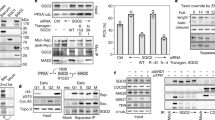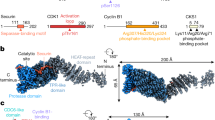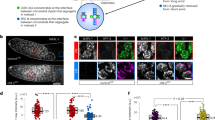Abstract
Cohesin pairs sister chromatids by forming a tripartite Scc1–Smc1–Smc3 ring around them1,2. In mitosis, cohesin is removed from chromosome arms by the phosphorylation- dependent prophase pathway3. Centromeric cohesin is protected by shugoshin 1 and protein phosphatase 2A (Sgo1–PP2A) and opened only in anaphase by separase-dependent cleavage of Scc1 (refs 4, 5, 6). Following chromosome segregation, centrioles loosen their tight orthogonal arrangement, which licenses later centrosome duplication in S phase7. Although a role of separase in centriole disengagement has been reported, the molecular details of this process remain enigmatic8,9. Here, we identify cohesin as a centriole-engagement factor. Both premature sister-chromatid separation and centriole disengagement are induced by ectopic activation of separase or depletion of Sgo1. These unscheduled events are suppressed by expression of non-cleavable Scc1 or inhibition of the prophase pathway. When endogenous Scc1 is replaced by artificially cleavable Scc1, the corresponding site-specific protease triggers centriole disengagement. Separation of centrioles can alternatively be induced by ectopic cleavage of an engineered Smc3. Thus, the chromosome and centrosome cycles exhibit extensive parallels and are coordinated with each other by dual use of the cohesin ring complex.
This is a preview of subscription content, access via your institution
Access options
Subscribe to this journal
Receive 12 print issues and online access
$209.00 per year
only $17.42 per issue
Buy this article
- Purchase on Springer Link
- Instant access to full article PDF
Prices may be subject to local taxes which are calculated during checkout





Similar content being viewed by others
References
Gruber, S., Haering, C. H. & Nasmyth, K. Chromosomal cohesin forms a ring. Cell 112, 765–777 (2003).
Haering, C. H., Farcas, A. M., Arumugam, P., Metson, J. & Nasmyth, K. The cohesin ring concatenates sister DNA molecules. Nature 454, 297–301 (2008).
Hauf, S. et al. Dissociation of cohesin from chromosome arms and loss of arm cohesion during early mitosis depends on phosphorylation of SA2. PLoS Biol. 3, e69 (2005).
Kitajima, T. S. et al. Shugoshin collaborates with protein phosphatase 2A to protect cohesin. Nature 441, 46–52 (2006).
Riedel, C. G. et al. Protein phosphatase 2A protects centromeric sister chromatid cohesion during meiosis I. Nature 441, 53–61 (2006).
Uhlmann, F., Wernic, D., Poupart, M. A., Koonin, E. V. & Nasmyth, K. Cleavage of cohesin by the CD clan protease separin triggers anaphase in yeast. Cell 103, 375–386 (2000).
Wong, C. & Stearns, T. Centrosome number is controlled by a centrosome-intrinsic block to reduplication. Nat. Cell Biol. 5, 539–544 (2003).
Tsou, M. F. & Stearns, T. Mechanism limiting centrosome duplication to once per cell cycle. Nature 442, 947–951 (2006).
Tsou, M. F. et al. Polo kinase and separase regulate the mitotic licensing of centriole duplication in human cells. Dev. Cell 17, 344–354 (2009).
Ganem, N. J., Godinho, S. A. & Pellman, D. A mechanism linking extra centrosomes to chromosomal instability. Nature 460, 278–282 (2009).
Stemmann, O., Zou, H., Gerber, S. A., Gygi, S. P. & Kirschner, M. W. Dual inhibition of sister chromatid separation at metaphase. Cell 107, 715–726 (2001).
Zou, H., McGarry, T. J., Bernal, T. & Kirschner, M. W. Identification of a vertebrate sister-chromatid separation inhibitor involved in transformation and tumorigenesis. Science 285, 418–422 (1999).
Gorr, I. H., Boos, D. & Stemmann, O. Mutual inhibition of separase and Cdk1 by two-step complex formation. Mol. Cell 19, 135–141 (2005).
Beauchene, N. A. et al. Rad21 is required for centrosome integrity in human cells independently of its role in chromosome cohesion. Cell Cycle 9, 1774–1780 (2010).
Gregson, H. C. et al. A potential role for human cohesin in mitotic spindle aster assembly. J. Biol. Chem. 276, 47575–47582 (2001).
Guan, J., Ekwurtzel, E., Kvist, U. & Yuan, L. Cohesin protein SMC1 is a centrosomal protein. Biochem. Biophys. Res. Commun. 372, 761–764 (2008).
Kong, X. et al. Cohesin associates with spindle poles in a mitosis-specific manner and functions in spindle assembly in vertebrate cells. Mol. Biol. Cell 20, 1289–1301 (2009).
Nakamura, A., Arai, H. & Fujita, N. Centrosomal Aki1 and cohesin function in separase-regulated centriole disengagement. J. Cell Biol. 187, 607–614 (2009).
Wong, R. W. & Blobel, G. Cohesin subunit SMC1 associates with mitotic microtubules at the spindle pole. Proc. Natl Acad. Sci. USA 105, 15441–15445 (2008).
Losada, A., Yokochi, T. & Hirano, T. Functional contribution of Pds5 to cohesin-mediated cohesion in human cells and Xenopus egg extracts. J. Cell Sci. 118, 2133–2141 (2005).
Boos, D., Kuffer, C., Lenobel, R., Korner, R. & Stemmann, O. Phosphorylation-dependent binding of cyclin B1 to a Cdc6-like domain of human separase. J. Biol. Chem. 283, 816–823 (2008).
Holland, A. J. & Taylor, S. S. Cyclin-B1-mediated inhibition of excess separase is required for timely chromosome disjunction. J. Cell Sci. 119, 3325–3336 (2006).
Thein, K. H., Kleylein-Sohn, J., Nigg, E. A. & Gruneberg, U. Astrin is required for the maintenance of sister chromatid cohesion and centrosome integrity. J. Cell Biol. 178, 345–354 (2007).
Cordingley, M. G., Callahan, P. L., Sardana, V. V., Garsky, V. M. & Colonno, R. J. Substrate requirements of human rhinovirus 3C protease for peptide cleavage in vitro . J. Biol. Chem 265, 9062–9065 (1990).
Bornkamm, G. W. et al. Stringent doxycycline-dependent control ofgene activities using an episomal one-vector system. Nucleic Acids Res. 33, e137 (2005).
Faragher, A. J. & Fry, A. M. Nek2A kinase stimulates centrosome disjunction and is required for formation of bipolar mitotic spindles. Mol. Biol. Cell 14, 2876–2889 (2003).
Loncarek, J., Hergert, P. & Khodjakov, A. Centriole reduplication during prolonged interphase requires procentriole maturation governed by Plk1. Curr. Biol. 20, 1277–1282 (2010).
Lenart, P. et al. The small-molecule inhibitor BI 2536 reveals novel insights into mitotic roles of polo-like kinase 1. Curr. Biol. 17, 304–315 (2007).
Sumara, I. et al. The dissociation of cohesin from chromosomes in prophase is regulated by Polo-like kinase. Mol. Cell 9, 515–525 (2002).
Gandhi, R., Gillespie, P. J. & Hirano, T. Human Wapl is a cohesin-binding protein that promotes sister-chromatid resolution in mitotic prophase. Curr. Biol. 16, 2406–2417 (2006).
Kueng, S. et al. Wapl controls the dynamic association of cohesin with chromatin. Cell 127, 955–967 (2006).
Gimenez-Abian, J.F. et al. Regulation of sister chromatid cohesion between chromosome arms. Curr. Biol. 14, 1187–1193 (2004).
Salic, A., Waters, J. C. & Mitchison, T. J. Vertebrate shugoshin links sister centromere cohesion and kinetochore microtubule stability in mitosis. Cell 118, 567–578 (2004).
Tang, Z., Sun, Y., Harley, S.E., Zou, H. & Yu, H. Human Bub1 protects centromeric sister-chromatid cohesion through Shugoshin during mitosis. Proc. Natl Acad. Sci. USA 101, 18012–18017 (2004).
McGuinness, B. E., Hirota, T., Kudo, N. R., Peters, J. M. & Nasmyth, K. Shugoshin prevents dissociation of cohesin from centromeres during mitosis in vertebrate cells. PLoS Biol 3, e86 (2005).
Wang, X. et al. sSgo1, a major splice variant of Sgo1, functions in centriole cohesion where it is regulated by Plk1. Dev. Cell 14, 331–341 (2008).
Uhlmann, F. & Nasmyth, K. Cohesion between sister chromatids must be established during DNA replication. Curr. Biol. 8, 1095–1101 (1998).
Elbashir, S. M. et al. Duplexes of 21-nucleotide RNAs mediate RNA interference in cultured mammalian cells. Nature 411, 494–498 (2001).
Kumagai, A. & Dunphy, W. G. The cdc25 protein controls tyrosine dephosphorylation of the cdc2 protein in a cell-free system. Cell 64, 903–914 (1991).
Bornens, M. & Moudjou, M. Studying the composition and function of centrosomes in vertebrates. Methods Cell Biol. 61, 13–34 (1999).
Acknowledgements
We thank M. Hermann, L. Mohr, A. Rehn and B. Sünkel for technical assistance, H. Bujard for pRTS1, D. van Essen, S. Saccani and S. Heidmann for anti-GFP, E. A. Nigg for anti-C-NAP1 and J. L. Salisbury for anti-centrin, K. Mayer for introducing us to the centrosome isolation procedure and S. Geimer, S. Heidmann and members of the Stemmann lab for discussions. This work was supported by grants of the Deutsche Forschungsgemeinschaft (grant SPP1384) and Deutsche Krebshilfe to O.S.
Author information
Authors and Affiliations
Contributions
L.S. carried out all experiments, M.M. created the episomal cell lines, helped with cloning of TEV-Smc3 and independently reproduced many experiments, B.M. produced Plk1, designed the experiment shown in Fig. 3b and independently confirmed several experiments, D.B. started the project and O.S. designed the research and wrote the paper.
Corresponding author
Ethics declarations
Competing interests
The authors declare no competing financial interests.
Supplementary information
Supplementary Information
Supplementary Information (PDF 473 kb)
Rights and permissions
About this article
Cite this article
Schöckel, L., Möckel, M., Mayer, B. et al. Cleavage of cohesin rings coordinates the separation of centrioles and chromatids. Nat Cell Biol 13, 966–972 (2011). https://doi.org/10.1038/ncb2280
Received:
Accepted:
Published:
Issue Date:
DOI: https://doi.org/10.1038/ncb2280



